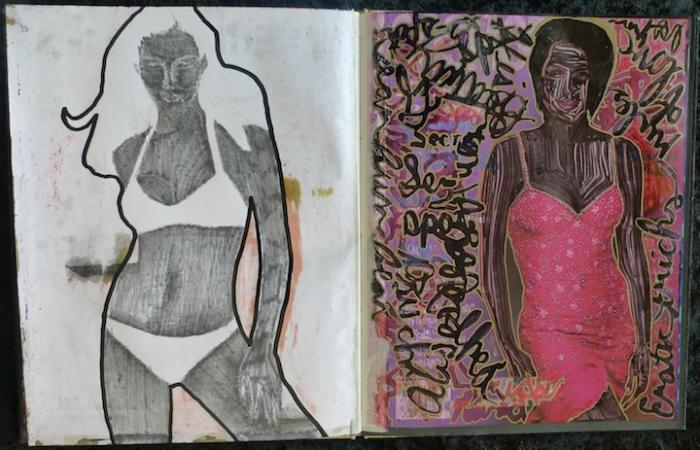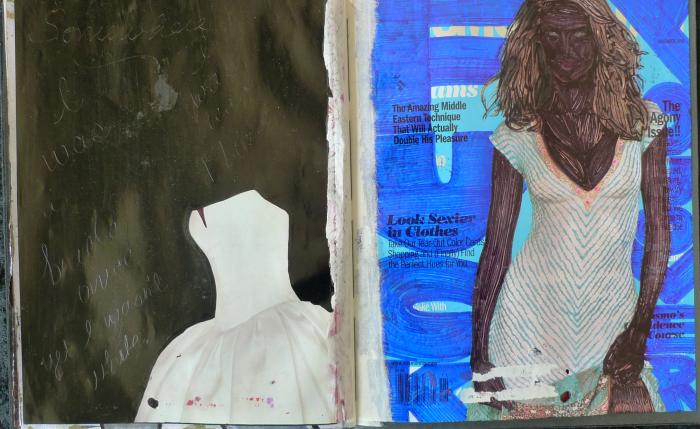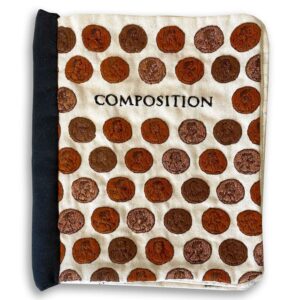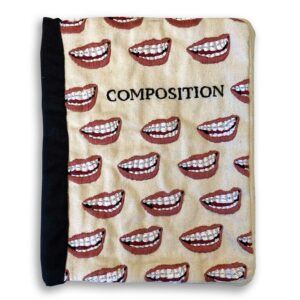- You cannot add "Common Threads V. 121" to the cart because the product is out of stock.
Your Eyes Make You Panic, unique
Your Eyes Make You Panic, unique
Date
2011
Edition Size
unique
Media
Acrylic, Collage, Hand-painting, Marker pen, Offset print, Pencil
Binding
Hand-sewn
Format
Artist Book
Collection
Unique Books$ 4,200.00
Unavailable
View Collectors
Library of Congress (LoC)
Tebbe subscribed to “Cosmopolitan” magazine for a year and collaged each figure on the cover and then sent the 12 covers to Weber who created poetry concrete from the cover text. Tebbe later, after the binding of the original altered covers, drew the backs of said covers.
These are the original mix marker, acrylic collages that were reproduced for the magazine version that was the second publication in a five-part series.
First edition, 1999, second edition 2000, both 16 pages, editions of 23
January 1999
Come die so Dom Sin
sin stain ass anal
Sue Maim Messy
eros Clothed
Tit ho
no slut sres ruts
odd Fig Beat Teat ShaftFebruary 1999
His Him Him His He’s
Grab-Me Kiss-Me Lips
Girlfriend
Fear
Fear
RapeMarch 1999
Find Touch Watch Him
Stop Love
Fertility
Babies
Right to Life
Forget the New
Body
Love Demons
Master Man
The Truth
CrashApril 1999
Desire
Tear-Out
Love Now
Stop
Your Eyes Make You Panic
June 1999
Sex
Men
Man’s Body
Studs
Begging
Money Success
Happiness
Freak
Mind Trick Makes
You His Fantasy
Kiss and Tell
Women got HitJuly 1999
Sex Trick
Flames
Boyfriend
Break Down
Cut Sex
Naked
Bitch
Adults-Only
Get AwayDecember 1999
May 1999
SlaveOctober 1999
November 1999
Fuck You OverAugust 1999
Sex Soul Price
Trick Blow Him Need
to Make You Forever Him
The Magazine Excavation Series, Marshall Weber’s Perspective
After I relocated from San Francisco to Madison, Wisconsin in 1992 (due to love!), I was in a state of depression and unemployment, had no gallery or institutional connections. While I was deeply in love and basically had no regrets (I was a little tired of the persona I had constructed for myself in San Francisco and needed a change) I was adrift and didn’t even have enough money to buy paper or other art supplies. Last time I had been in this sort of situation I had started collaging dollar bills (in a closet studio space under a stairway in the S.F. Mission District), the resulting collages re-established my art career and ironically (or maybe not) was one of my most successful series financially. But those funds were long spent and here I was in the middle of a Wisconsin winter sitting at home while my girlfriend went to school and work, wondering what would come next. I turned in an application to the local Burrito hut – and didn’t receive a response!
So there I was watching the shopping catalogs drop through the mail slot – sheer boredom, outrage at the vast amounts of trees and money literally thrown out by the catalog industry and a jealous desire to disrupt the flow of crass objectification of both the female and male body prompted me to start painting on, smearing and ripping the catalog apart – and then reconstructing them as a critique of themselves.
I learned quite a lot about the fashion industry, how shopping catalog are designed, who the designers were, and who the models were. Stephanie Alter being my favorite – you can see her in quite a few of my pieces, she’s famous for her Victoria Secret ads and for turning in and pressing charges for aggravated assault against a former boyfriend – Axel Rose of the trash-rock band Guns and Roses – right on Stephanie! – thus proving that nothing is quite as simple as we would like to believe – and that a woman can have a job modeling underwear and still have fortitude and integrity. Stephanie ALTERED became a sort of muse for me…
Again fate would weigh in on my favor and brilliant artist, book historian and proprietor of Artichoke Yink Press Christopher Wilde, looked at my collages and asked if AYP could publish them in a simulacra shopping catalog form that would completely mimic the shopping catalog. Initially I had actually just snuck copies of “The Catalog” onto newsstands just to see people’s reactions, then after relocating to New York City, I started selling them at Printed Matter for $50.00 a pop – they quickly sold out and via AYP and then the newly formed Booklyn strategically distributed “The Catalog” to museums and libraries, the going price soared to $750.00 a copy and a art star was born.
Other true Magazine Excavations paralleled the simulacra magazines, by gluing and nailing the edges of various magazines together, I realized that magazine structure was so consistent that I could intuitively design collage just by cutting into the magazine – the structure and content so tightly wound together that the magazine would practically deconstruct itself on the studio operating table.
Soon followed the pieces that Felice Tebbe discusses in her essay, as my interest in the fashion world and the world of magazine publishing peaked the final projects birthed. “The Passion” was the ultimate, dedicated to anorexic, drug addicted super model catastrophe Gia. It was the ultimate, transubstantiating the fashion model into the Christ who bears the burdens of our consumerist sin. Then finally on to DKNYFDO3, where Felice and I obliquely say good bye to the world of fashion magazines, with their mechanisms of sexism, comodification, gender stratification and their brilliant and often beautiful evocations of the human body and the apparel we choose to drape it with.
In closing I want to thank Barbara Polowy of Smith College’s Hilyer Art Library and Martin Antonetti the Special Collections Librarian of Smith College’s Neilson Library for supporting my and Booklyn’s work for many years. I believe that this exhibit and project is most pertinent to Smith College’s curriculum and mission; both support an exploration of the resources and power of women (and men) in the face of the vast corporate machine of desire that continuously attempts to dismantle women’s self esteem in the hope’s that a purchase or two (or infinity!) will restore it and that also attempts to define who we all are in terms of our identity and desire. Art has always creatively confronted these dehumanizing systems with revealing critiques and hopeful visions of better possibilities and realities; I hope that the Magazine Excavations add to this dialog, and I hope we all find and trust to our self esteem, our desires and our identities where they all truly exist – inside ourselves.
The Magazine Excavation Series, Collaborator Felice Tebbe’s Perspective
I had seen Marshall Weber’s catalogues in 1998 before I left the New York area to attend graduate school in Iowa. Honestly, I couldn’t digest the meaning of them when I saw them. The layout shocked me. I chose not to sort the meaning of the “male gaze” and myself because I was preoccupied with the time. I had read the beauty-image feminist writing and had been quite taken by it. But at the time, I didn’t want to engage. It was on hold.
Just before I started the magazine collaboration with Marshall Weber, I was actually subscribing to Cosmopolitan. I should just be embarrassed. But, I’m not. I am fascinated by it. I was looking for some information on how to be a sexual woman in this country. The limited awareness in which I was engaged still amazes me.
One day, I actually saw the model on the cover for the first time. It smacked me. It really appeared to me as, a drawing, a fabrication. I have looked/touched my own body as a beautiful thing; it’s shapely hips, curves, and softness. I always have been an expert in watching & seeing beauty’s swift flickers. I perceived this model as being plastic. She is the image of woman in our culture. I had to act.
These women who are built like boys and yet are what men & women both want to look like & perceive as desirable. This shocked me. I spontaneously wanted to void, negate the image immediately. I grabbed my sharpie & went to it. At the time, I was partly working within 20 feet of a collection of African Art. I brought my knowledge of the face & body from a drawing boot camp I participated in Wisconsin. I went to it.
Masks & a coat of tar ensued. I cannot clearly define why this was how I rendered the figures. I had a hard time looking at the drawings & accepting them as valid artwork. The politically correct police were in my mind hounding me—this isn’t art. But I did a bunch of covers & I sent them to Marshall. I think I had met him once in passing at the time. Thankfully, he was floored and got to work. The series followed between us for about a year & then we had a book. I remember making the cover image from the back of one of the drawings.
I showed them in Iowa to a group of painters for critique. I remember two things from that conversation: one was the position of the professor’s body in relation to mine during the conversation & the other was a response that a girl said. “Do you hate women?” she asked. In my mind, beneath my reaction of shock, I thought these aren’t women, they’re fabrications. Sometimes I wish I had my current confidence then. I would have spoken right up. But, sometimes silence is a good answer.
I started the MAIM series with the thought that we should do a male magazine partner to Your Eyes Make Me Panic. Right from its Tebbench, I’ve hated that magazine. It seems to be acceptable pornography that any man can read in front of their wives. But the reality is even worse.
The collages in MAIM are extracting an element from that month’s edition & building the figure from those contents. There are phallic symbols: an actors eyes gazing, fabric, skin, et al. It was my first true stab at collage. I started in January. By September, continuing until the end of the year, the beauty of the figures as forms in themselves began to dominate it’s own content. In commenting on Marshall’s additions & finishing of these covers, I have a mental skip trying to interpret my reaction to them verbally. It’s visceral. He took the work smoothly & finished them with a powerful push. I couldn’t be more pleased.
My collaboration with Marshall is ironic because I can add up the time we’ve spent in each other’s company on one of my hands. The minutes would probably be less than an hour & twenty minutes. But I cherish his production. I drink his work in now. It’s essential. It secretly brought me back to my own words & invited them onto my canvases.
They were always supposed to be there. And I honestly had no idea. We are brother & sister of the page.









